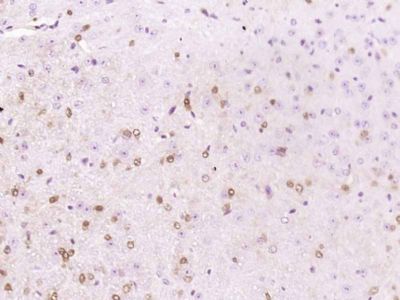APBA1 Polyclonal Antibody
Purified Rabbit Polyclonal Antibody (Pab)
- 产品详情
- 实验流程
Application
| WB, IHC-P, IHC-F, IF, ICC, E |
|---|---|
| Primary Accession | Q02410 |
| Reactivity | Rat, Pig, Dog, Bovine |
| Host | Rabbit |
| Clonality | Polyclonal |
| Calculated MW | 92865 Da |
| Physical State | Liquid |
| Immunogen | KLH conjugated synthetic peptide derived from human APBA1 |
| Epitope Specificity | 451-550/837 |
| Isotype | IgG |
| Purity | affinity purified by Protein A |
| Buffer | 0.01M TBS (pH7.4) with 1% BSA, 0.02% Proclin300 and 50% Glycerol. |
| SUBCELLULAR LOCATION | Nucleus. |
| SIMILARITY | Contains 2 PDZ (DHR) domains. Contains 1 PID domain. |
| SUBUNIT | Part of a multimeric complex containing Munc18-1 and syntaxin-1. Also part of the brain-specific heterotrimeric complex LIN-10/X11-alpha, LIN-2/CASK, and LIN7. Binds to the cytoplasmic domain of amyloid protein (APP). Interacts (via PDZ 1 and 2 domains) with FSPB. |
| Important Note | This product as supplied is intended for research use only, not for use in human, therapeutic or diagnostic applications. |
| Background Descriptions | The Beta-Amyloid precursor protein (Beta-APP) is a major constituent of the amyloid deposits in patients with Alzheimer’s disease. The Beta-Amyloid precursor is known to interact with several proteins, including X11 and the G heterotrimetric protein APP-BP1. The neuronal, transmembrane protein X11 is known to bind to the ∫-Amyloid precursor protein via a phosphotyrosine binding (PTB) domain, reducing the secretion of cellular Beta-APP and slowing Beta-APP processing pathways. X11 binds specifically to the YENPTY motif, which is involved in the internalization of Beta-APP. Multiple splice varitents of X11 have been identified, including X11å (also designated Mint 1), X11Beta (Mint 2) and X11(Mint 3). |
| Gene ID | 320 |
|---|---|
| Other Names | Amyloid-beta A4 precursor protein-binding family A member 1, Adapter protein X11alpha, Neuron-specific X11 protein, Neuronal Munc18-1-interacting protein 1, Mint-1, APBA1, MINT1, X11 |
| Target/Specificity | Brain and spinal cord. |
| Dilution | WB=1:500-2000,IHC-P=1:100-500,IHC-F=1:100-500,ICC=1:100-500,IF=1:100-500,ELISA=1:5000-10000 |
| Format | 0.01M TBS(pH7.4) with 1% BSA, 0.09% (W/V) sodium azide and 50% Glyce |
| Storage | Store at -20 °C for one year. Avoid repeated freeze/thaw cycles. When reconstituted in sterile pH 7.4 0.01M PBS or diluent of antibody the antibody is stable for at least two weeks at 2-4 °C. |
| Name | APBA1 |
|---|---|
| Synonyms | MINT1, X11 |
| Function | Putative function in synaptic vesicle exocytosis by binding to Munc18-1, an essential component of the synaptic vesicle exocytotic machinery. May modulate processing of the amyloid-beta precursor protein (APP) and hence formation of APP-beta. Component of the LIN-10- LIN-2-LIN-7 complex, which associates with the motor protein KIF17 to transport vesicles containing N-methyl-D-aspartate (NMDA) receptor subunit NR2B along microtubules (By similarity). |
| Cellular Location | Cytoplasm. Cytoplasm, perinuclear region. Nucleus. Note=Only about 5% of the protein is located in the nucleus |
| Tissue Location | Brain and spinal cord. Isoform 2 is expressed in testis and brain, but not detected in lung, liver or spleen |
Research Areas
For Research Use Only. Not For Use In Diagnostic Procedures.
Application Protocols
Provided below are standard protocols that you may find useful for product applications.
终于等到您。ABCEPTA(百远生物)抗体产品。
点击下方“我要评价 ”按钮提交您的反馈信息,您的反馈和评价是我们最宝贵的财富之一,
我们将在1-3个工作日内处理您的反馈信息。
如有疑问,联系:0512-88856768 tech-china@abcepta.com.























 癌症的基本特征包括细胞增殖、血管生成、迁移、凋亡逃避机制和细胞永生等。找到癌症发生过程中这些通路的关键标记物和对应的抗体用于检测至关重要。
癌症的基本特征包括细胞增殖、血管生成、迁移、凋亡逃避机制和细胞永生等。找到癌症发生过程中这些通路的关键标记物和对应的抗体用于检测至关重要。 为您推荐一个泛素化位点预测神器——泛素化分析工具,可以为您的蛋白的泛素化位点作出预测和评分。
为您推荐一个泛素化位点预测神器——泛素化分析工具,可以为您的蛋白的泛素化位点作出预测和评分。 细胞自噬受体图形绘图工具为你的蛋白的细胞受体结合位点作出预测和评分,识别结合到自噬通路中的蛋白是非常重要的,便于让我们理解自噬在正常生理、病理过程中的作用,如发育、细胞分化、神经退化性疾病、压力条件下、感染和癌症。
细胞自噬受体图形绘图工具为你的蛋白的细胞受体结合位点作出预测和评分,识别结合到自噬通路中的蛋白是非常重要的,便于让我们理解自噬在正常生理、病理过程中的作用,如发育、细胞分化、神经退化性疾病、压力条件下、感染和癌症。






